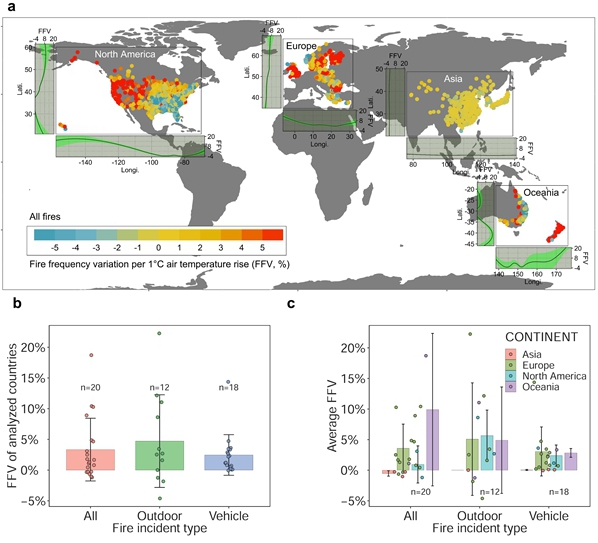The frequency of some types of fires in cities as a result of climate change is projected to increase in the coming decades, according to a study published in Nature Cities. The findings are based on data from 2,847 cities in 20 countries and could be useful for future urban planning and emergency response strategies. Fires across the world cause an estimated 50,000 deaths and 170,000 injuries every year. However, future trends of fire frequency in urban environments are uncertain, even though they often cause more human casualties and economic damage than some other fire types, such as wildfires. This lack of understanding might compromise regional fire resource management and urban planning. Professor Long Shi at the University of Science and Technology of China and his colleagues gathered data from urban fire departments in 2,847 cities across 20 countries—including the USA, UK, Australia, and China—to establish a global database of city-level fire incidents for 2011–2020. They then quantified changes in the frequency of various types of urban-fire incident, including the burning of city buildings, vehicles, and outdoor areas (such as landfill sites), in response to a warming climate. Using this historical dataset, they assessed the likely effect of global warming on the frequency of the various urban fire types, based on different Intergovernmental Panel on Climate Change (IPCC) climate scenarios. They projected that, by 2100, there could be an 11.6% increase in vehicle fires and a 22.2% increase in outdoor fires, but a 4.6% decrease in building fires, under a high greenhouse gas emission scenario (SSP5–8.5). They also report an estimated total of 335,000 fire-related deaths and 1.1million fire-related injuries between 2020 and 2100, attributable to global warming, across all cities in this study.
The authors of this finding include Professor Long Shi (University of Science and Technology of China, China), Associate Professors Jinhui Wang (Shanghai Maritime University, China) and Guohui Li (Tianjin Fire Research Institute of Ministry of Public Security, China), Professors Michael Yit Lin Chew (National University of Singapore, Singapore), Heping Zhang (University of Science and Technology of China, China), Guomin Zhang (RMIT University, Australia) and Bogdan Z. Dlugogorski (Charles Darwin University, Australia). The full text of this paper can be found at www.nature.com/articles/s44284-025-00204-2.

Fig. 1 Fire frequency variation per 1 °C rise in air temperature (FFV). The FFV (in %) of the 2,847 analysed cities for all fire incidents. Each dot represents a city. “All fires” are a combination of all fire incidents collected by fire departments. Fire frequency corresponds to the annual number of fire incidents per thousand population. The smooth lines represent the relationships between latitude/longitude and FFV obtained by the locally weighted smoothing method.
